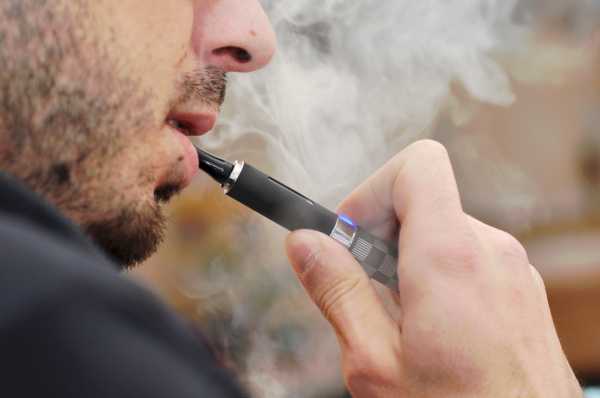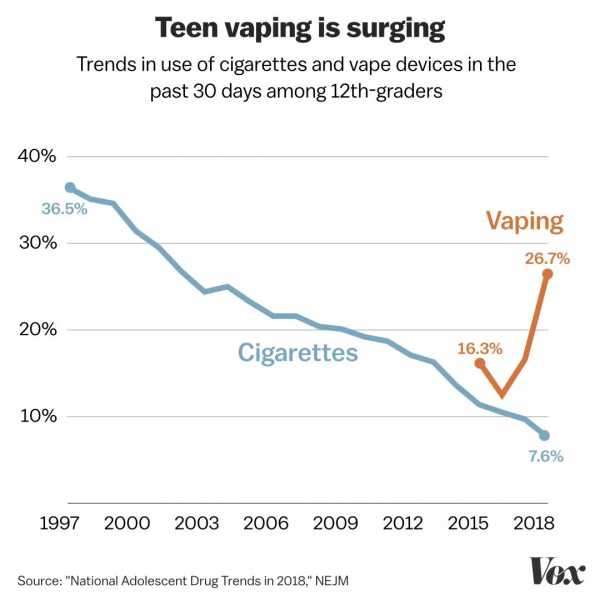
More than 200 people across the US have come down with a mysterious illness that appears to be linked to vaping — the latest wake-up call to the potentially serious health risks of using e-cigarettes.
As of August 27, there were 215 cases of severe respiratory disease in 25 states since late June, the Centers for Disease Control and Prevention (CDC) reported Friday. All patients reported using e-cigarette products. But while officials believe their illness is associated with vaping, they haven’t been able to single out which ingredient or device may be causing the problem.
So far, the patients have a few things in common. They suffered from respiratory symptoms, including coughing, shortness of breath, chest pain, and difficulty breathing. Some have gotten seriously ill, even winding up in intensive care units on oxygen support through ventilators or intubation. Most are in their late teens and 20s with no underlying health issues. Many cases also involved vaping THC-containing liquids (though it’s not clear whether that was from cannabis e-cigs or nicotine e-cigs), and the CDC singled out black market products as another potential commonality.
“Anyone who uses e-cigarette products should not buy these products off the street (e.g., e-cigarette products with THC or other cannabinoids) and should not modify e-cigarette products or add any substances to these products that are not intended by the manufacturer,” the CDC warned. “E-cigarette products should not be used by youth, young adults, pregnant women, as well as adults who do not currently use tobacco products.”
But that’s not the only alarming health problem linked to vaping lately — and that’s why the way we view the safety of these devices is likely to change in the coming weeks and years. Here’s what we know so far.
Doctors are treating a disease of unknown origin
Patients who have come down with the mystery illness started to experience symptoms anywhere from a few days to several weeks after using e-cigarettes. Respiratory problems were the most common but some people also reported nausea, vomiting, diarrhea, fatigue, fever, and weight loss.
While doctors have tried to find a common bacterial or viral source of the disease, they’ve failed to turn anything up. The patients only have vaping in common, but no specific products or substances link the cases together. That’s why an investigation is underway, and officials are urging doctors and the public to report potential cases.
In the absence of a known cause, treating patients has proven tricky. Doctors have to consider a range of triggers, according to the CDC. Even though some patients who have been treated with steroids have shown improvement, health care providers are advised to only prescribe them on a case-by-case basis.
The illness caused the first known vaping death in America — and that’s scary given what we know about who is vaping
In the coming days, there may be more cases. It’s possible the death toll will rise, too.
On August 23, officials reported the first death linked to vaping amid the spate of illnesses. The patient — an adult woman in her 30s based in Illinois — with severe respiratory disease was hospitalized after vaping, and died. No other details about the patient, what vaping products she used, or her health status, were released to the public.
The potential seriousness of the disease is particularly frightening given who it seems to be mostly affecting: young people in their late teens and early 20s. This isn’t surprising since we know vaping has surged in this group.

According to a 2018 National Institutes of Health survey, which has tracked substance use among American adolescents, the number of high school seniors who say they vaped nicotine in the past 30 days has doubled since 2017 — from 11 percent to nearly 21 percent. That’s the largest increase ever recorded for any substance in the survey’s 43-year history. And it means a quarter of 12th-grade students are now using, at least occasionally, a nicotine device that’s so new, we have no idea what the long-term health impact of using it will be.
The number of 12th graders who used any type of e-cigarette in the past 30 days was even higher: 27 percent. In 2018, we also learned that the number of high schoolers who used e-cigarettes in the past 30 days increased by about 75 percent since 2017. By contrast, fewer than 5 percent of adults currently use e-cigarettes.
While the respiratory illnesses may be new, we already know breathing vapor into lungs can irritate them
Even before the appearance of the mystery illness, researchers have been finding that vapor can irritate the lungs.
Researchers recently tracked 28,000 adults to tease out whether e-cigarettes exacerbate wheezing. Some of the people in the study were current vapers who used only e-cigarettes; others were smokers only; still others were dual users (who smoked and vaped); and finally, there were also folks who didn’t smoke or vape at all.
Compared with that last group, the non-users, the risk of wheezing among the vapers nearly doubled.
When the researchers looked at the study participants’ history of vaping or smoking, they came to even more interesting findings: The risk of wheezing was higher in current vapers who were also ex-smokers than in ex-smokers who did not vape. In other words, it wasn’t just a vaper’s potential history of smoking that was driving the uptick in wheezing among vapers. “Therefore,” the authors concluded, “promoting complete cessation of both smoking and vaping will be beneficial to maximize the risk reduction of wheezing and other related respiratory symptoms.”
Other studies have focused on whether e-cigarette users are more likely to develop chronic obstructive pulmonary disease (COPD), a set of lung complications that make it hard to breathe. Research in mice and human airway cells showed that nicotine-containing e-cigarette vapor seemed to trigger “effects normally associated with the development of COPD.”
In preliminary human studies, researchers also found associations between regular vaping and COPD. But again, this human research was observational, not experimental, so it’s not yet clear that vaping caused COPD. (For example, it’s possible the people who have COPD are more likely to use electronic cigarettes, such as ex-smokers seeking a harm reduction method.)
Vaping has been tied to other serious health problems
There’s still a lot we don’t know about the short- and long-term effects of using e-cigarette products, mostly because they haven’t been on the market for very long (and diseases related to vaping may take years or even decades to manifest).
Among the myriad health concerns: The FDA has been warning that nicotine-induced seizures could be a rare side effect of vaping.
There are also nicotine’s heart health concerns. “Nicotine [in e-cigarettes] does the same thing as [combustible] cigarettes,” Neal Benowitz, a professor of medicine at the University of California San Francisco who’s been studying the link between e-cigarettes and heart health, told Vox previously. It can increase the adrenaline circulating in our bodies and activate the sympathetic nervous system (our “fight or flight” response), raising blood pressure, speeding up the heart rate, and causing the arteries — the vessels that carry blood — to narrow.
Even when vapor is nicotine-free, it may carry other heart health risks. The heating element in e-cigarettes emits tiny particles, sometimes including metals, which can lodge themselves deep into the lungs and get absorbed into the body’s circulatory system. “That’s where we see the potential cardiovascular toxicity,” Maciej Goniewicz, one of the leading e-cigarette researchers based at Roswell Park Comprehensive Cancer Center in Buffalo, New York, told Vox previously.
Recent studies have shown that puffing on e-cigarettes increases concentration of these microscopic pollutants — in particular, PM2.5 and ultrafine particles — in indoor environments.
Researchers don’t yet know what risks e-cigarette aerosol particles carry, but these tiny particles have been studied extensively in the context of air pollution and tobacco smoking. In those studies, researchers have linked exposure to small particles with a range of bad cardiovascular outcomes, including heart attacks, high blood pressure, and coronary artery disease.
Long-term health risks aside, a recent New England Journal of Medicine case study described a 17-year-old Nevada teenager who showed up in the emergency room after a VGOD e-cigarette exploded in his mouth. “He had a circular puncture to the chin, extensive lacerations in his mouth, multiple disrupted lower incisors, and bony incongruity of the left mandible,” the doctors who treated the boy wrote in their report.
For now, the spate of illness tied to vaping is a reminder that there are a lot of products out there that haven’t been tested by officials or regulated in any way.
“These [new] cases demonstrate the importance of effective regulation,” said David Liddell Ashley, a former director of the office of science in the Center for Tobacco Products at the FDA. “Without premarket testing, reporting, and review, consumers become the test subjects.”
Sourse: vox.com






